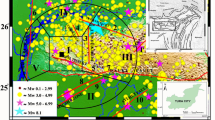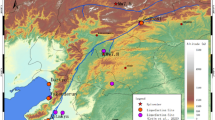Abstract
Slope failures triggered by earthquakes are among the most important soil mechanics problems. In this study, static and pseudostatic analyses of slope stability for earthquake conditions were carried out in the Gurpinar area. In situ testing (SPT) was carried out and laboratory samples were obtained from six boreholes (maximum depth 50.0 m) to determine soil classification and strength characteristics. Geophysical studies (seismic refraction and MASW) were also carried out in the area to estimate the structure and stiffness strength characteristics of the slope to 50.0 m depth. All field and laboratory data were used to determine the mechanical and structural (geometrical) behavior of the slope. In order to solve the slope stability problem, three soil slope models were considered. Pseudostatic analysis was carried out to estimate the earthquake acceleration seismic hazard in the region. These analyses showed that, while there was no potential slope instability under static load conditions, some problems would appear with increasing earthquake acceleration. A geotechnical slope improvement project is proposed for the study area.














Similar content being viewed by others
References
Abrahamson NA, Litehiser JJ (1989) Attenuation of vertical peak acceleration. BSSA 79(3):549–580
Alparslan E, Yüce H, Erkan B, Inan S, Ergıntav S, Saatçılar R (2006) Multi-criteria analysis of landslide susceptibility İn: The Area Between Büyükçekmece And Küçükçekmece Lakes Of !Stanbul City Using Remote Sensing And Gıs, 4th Gıs Days İn Türkiye, Sep 13–16, 2006/Fatih University/Istanbul-Türkiye
Ambraseys N, Zatopek A (1968) The Varto, Antolia, earthquake of 19 August 1966. Bull Seism Soc Amer 58:47–102
Bourdeau C, Havenith H, Fleurisson J, Grandjean G (2004) Numerical modelling of seismic slope stability, in engineering geology for infrastructure planning in Europe. Springer, Heidelberg
Campbell KW (1981) Near source attenuation of peak horizontal acceleration. Bull Seis Soc Am 71(6):2039–2070
Campbell KW (1997) Empirical near-source attenuation relationships for horizontal and vertical components of peak ground acceleration, peak ground velocity, and pseudo-absolute acceleration response spectra. Seismol Res Lett 68(1):154–179
Cherubini C, Santoro F, Vessia G (2004) Hazard assessment in dynamic slope stability analysis. In: Brebbia CA (ed) Risk analysis IV. Wessex Institute of Technology, UK
Dalgic S (2005) İstanbul ili, Büyükçekmece ilçesi, yerleşime uygun olmayan alanların jeolojik jeoteknik değerlendirme raporu, İÜ, Araştırma ve Yardım Vakfı
Dalgıç S, Turgut M, Kuşku I, Coşkun C, Çoşgun T (2009) The effect of soil and rock conditions on Construction Foundation on the European Side of İstanbul. Appl Earth Sci J Kocaeli University, 2:47–70
Das BM (1993) Principles of soil dynamics. HWS Publications, USA
Donovan NC (1973) A statistical evaluation of strong motion data including the February 9, 1971 San Fernando earthquake, World Conference on Earthquake Engineering, V, Rome, Proceedings, v. 2, paper 155, International Association for Earthquake Engineering, Instituto di Scienza e Techn? ca delle. Construzioni Politechico di Milano, Piazza da Leonardo da Vinci, 32, 20133 Milano, Italia
Douglas BM, Ryall A (1975) Return periods of rock accelerations in western Neveda. BSSA 65:1599–1611
Erdik M, Durukal E (2004) Strong ground motion. In: Ansal A (ed) Recent advances in earthquake geotechnical engineering and microzonation. Kluwer Academic Publishers, The Netherlands
Erdik M, Alpay Biro Y, Onur T, Sesetyan K, Birgoren G (1999) Assessment of earthquake hazard in Turkey and neighboring regions. Annali di Geofisica 42:1125–1138
Esteva L (1970) Seismic risk and sesmic design decisions, in seismic design for nuclear power plants. MIT Pres, Cambridge
Esteva L, Rosenblueth E (1964) Spectra of Earthquakes at modorate and large distances. Soc Mex De Ing Seismica, Mexico 11
Esteva L, Villaverde R (1973) Seismic risk, design spectra and structural reliability. Proceedings 5th World Conference on Earthquake Engineering., Rome 2, 2586–2596
Ezen Ü (1981) Earthquake source parameters related to magnitude along the North-Anatolian Fault zone. Bull Int Inst Seism Earth Eng (Japan) 19:33–55
Fukishima Y, Tanaka T, Kataoka S (1988) A new attenuation relationship for peak ground acceleration derived from strong motion accelerograms. Proceedings of IX WCEE, Tokyo
ISSMFE (1993) Manual for zonation on seismic geotechnical hazards, Japanese Soc Soil Mech Found Eng, Maruei Co., Ltd., Japan
JICA-IBB Report (2002) The study on a disaster prevention/mitigation basic plan in Istanbul including seismic microzonation in the Republic of Turkey, Final Report, Main Report, December 2002, Pacific Consultants International, OYO Corporation, Japan International Cooperation Agency (JICA), Istanbul Metropolitan Municipality (IMM), 729 p
Joyner WB, Boore DM (1981) Peak horizontal acceleration and velocity from strong motion records, including records from the 1979 Imperial Valley, California, earthquake. Bull Seis Soc Am 71(6):2011–2038
Hara A, Ohata T, Niwa M (1971) Shear modulus and shear strength of cohesive soils. Soils Found 14(3):1–12
Kanai K, Hisrano K, Yoshizawa S, Asada T (1966) Observation of strong earthquake motion in Matsushiro area, part 1. Bull Earthq Res Inst, Univ Tokyo 44:1269–1296 (In Japanese)
Matasovic N (1991) Selection of method for seismic slope stability analysis, Proceedings, Second International Conference on Recent Advances in Geotechnical Earthquake Engineering and Soil Dynamics, Paper no: 7.20
Matsuda T (1977) Estimation of future destructive earthquakes from active faults on land in Japan. J Phys Earth 25:S251–S260
McGuire RK (1984) Ground Motion Estimation In Regions With Few Data. VIII WCEE, vol 2. San Francisco, pp 327–334
Nazarian S, Stokoe IKH (1984) In-Situ shear wave velocities from spectral analysis of surface waves, Proceedings 8th Conference on Earthquake Engineering—S.Francisco, vol 3. Prentice-Hall, pp 31–38
Newmark NM, Rosenblueth E (1971) Fundamentals of earthquake engineering. Prentice Hall, New Jersy
Oliveira CS (1974) Seismic risk analysis, report no. EERC. 74-I, University of California, Berkeley
Park CB, Miller RD, Xia J (1999) Multichannel analysis of surface waves (MASW). Geophysics 64:800–808
Park CB, Miller RD, Xia J, Ivanov J (2007) Multichannel analysis of surface waves (MASW)—active and passive methods. The Leading Edge 2007:60–64
Shah HC, Huang MJ, Kremidjian AS, Zstutty TC (1984) A study of seismic risk for Nicaragua Part I. Report 11, The John A. Blume Earthquake Engineering Center, Stanford University, Stanford, California
Stokoe KH II, Wright GW, James AB, Jose MR (1994) Characterization of geotechnical sites by SASW method. In: Woods RD (ed) Geophysical characterization of sites. Oxford Pub, Oxford
Stroud MA (1974) The standard penetration test in insensitive clays and soft rocks. Proceedings of European seminar on penetration testing, Stockholm, pp 367–375
Tamura T (1978) An analysis of the relation ship between the areal distribution of earthquake-induced landslides and the earthquake magnitude. Geogr Rev Japan 51–58:662–672
Toksoz MN, Shakal AF, Michael AJ (1979) Space time migration of earth-quakes along the North Anatolian fault zone and seismic gaps. Pure Appl Geophys 117:1258–1270
Wells DL, Coppersmith KJ (1994) New empirical relationships among magnitude, rupture length, rupturewidth and surface displacement. Bull Seis Soc Am 84:974–1002
Author information
Authors and Affiliations
Corresponding author
Rights and permissions
About this article
Cite this article
Ozcep, F., Erol, E., Saraçoğlu, F. et al. Seismic landslide analysis: Gurpinar (Istanbul) as a case history. Environ Earth Sci 66, 1617–1630 (2012). https://doi.org/10.1007/s12665-010-0853-3
Received:
Accepted:
Published:
Issue Date:
DOI: https://doi.org/10.1007/s12665-010-0853-3




